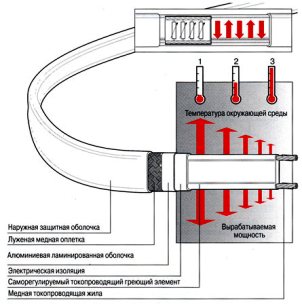Categories: Interesting Facts, Interesting electrical news
Number of views: 58953
Comments on the article: 5
The use of self-regulating heating cables
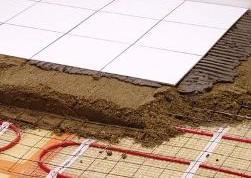 Cable heating: from underfloor heating to roofs without icicles.
Cable heating: from underfloor heating to roofs without icicles.
Recently, more and more widely used cable heating systems. The range of applications of such systems is becoming wider, their use is more economical, reliable and efficient. More recently, the scope of the heating cable was limited, perhaps, to the installation of underfloor heating.
Currently, the assortment of heating cables and even thermofilms has become much more extensive, which allows heating anything you want, from water pipes to roofs of buildings. But first, remember how it all began ...
The history of the development of the warm floor is rooted in the distant past and dates back several centuries, even if not millennia. A primitive semblance of a warm floor was found by archaeologists at excavations in the Lower Amur Region on the island of Suchu. The “warm floor” discovered by a group of scientists led by V.V. Medvedev dates back to 1800 - 1600 BC. The floor device was a so-called kan, which was made of wood coated with clay.
Of course, such a sex could not last long, but scientists believe that such a find convincingly proves that already more than three thousand years ago our ancestors strove to create comfort in their homes. The basis of the action of such a warm floor was a fire, followed by the passage of smoke through clay-coated wooden dies. Mention of such heat sources is found in the annals of China, as well as Primorye and Western Siberia.
Warm floors were also known in ancient Greece. Their heating was carried out by warm air from the furnace through pipes laid in the floor. Also, the history of underfloor heating in Turkish baths has been counting for centuries, the device of which is similar to the one just described.
In Russia, thanks to the introduction of advanced Western technologies, warm floors were widely used in the 90s of the last century. Their rapid distribution was facilitated by the fact that their device is quite simple, does not require special skills and expensive tools and equipment for installation and installation. Therefore, underfloor heating has become relatively cheap and affordable for many.
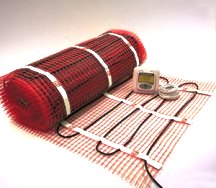 The use of a warm floor system is especially justified in cases where the floor covering is made of natural or artificial stone or ceramic tile. Such materials have an attractive appearance, practical and durable, but, unfortunately, are cold. Walking barefoot over them is simply unpleasant and can even cause colds. Imagine what will happen if a small child sits on such a floor.
The use of a warm floor system is especially justified in cases where the floor covering is made of natural or artificial stone or ceramic tile. Such materials have an attractive appearance, practical and durable, but, unfortunately, are cold. Walking barefoot over them is simply unpleasant and can even cause colds. Imagine what will happen if a small child sits on such a floor.
The first heated floors were built on the basis of resistive heating cable. Subsequently, new elements for creating a warm floor appeared. First of all, it is a two-core heating cable and floor mats based on it. Also becoming more widespread film floor heating. Its basis is a special thermal film, the action of which is based on the phenomenon of far-infrared radiation.
The advantages of a warm floor include several factors. The warm floor does not dry the air, it creates soft and even heat in the room. Here you can recall a popular proverb that legs should be kept warm and your head in the cold. If on the surface of the floor the temperature will be about 24 degrees, then at the level of the head within 18 ... 20, which is fully consistent with folk wisdom.
Also, the warm floor allows you to get rid of heating radiators, does not take up extra space and does not spoil the interior of the premises.An important advantage of this floor is also in low specific power in comparison with other heating systems.
The control of operating modes of the warm floor is carried out using temperature controllerscarrying out temperature control using special sensors. Sensors are installed inside a concrete screed together with heating elements.
Many modern temperature controllers (programmable thermostats) allow you to work in several modes programmed by the user. For example, during the day when there is no one at home, the minimum temperature is maintained, and by the evening it rises slightly. Other options are also possible: a low temperature is maintained in a country house on weekdays, and by the time the owners arrive on weekends it automatically increases to a predetermined level.
Such systems are good indoors. But often there are situations when you have to arrange cable heating in the open air or in an unheated room. And such situations are more than enough. Some of them are briefly described below.
Tank and pipe heating
 It is not a rare situation when a pipe freezing from a water well to a house freezes. Most often this happens in individual houses, where at night there is practically no water consumption.
It is not a rare situation when a pipe freezing from a water well to a house freezes. Most often this happens in individual houses, where at night there is practically no water consumption.
In apartment buildings, water flows through pipes always without ceasing, even at night. After all, for example, out of a hundred apartments, at least in a few taps they must leak, someone uses a washing machine at night - an automatic machine. This thin stream does not allow the pipe to freeze in the most severe frosts.
In industrial conditions, it is often necessary to maintain temperature in pipelines and tanks with a working fluid in accordance with the manufacturing process. In either case, the best solution to the problem is cable heating. The easiest way to arrange such a heating is with self-regulating heating cable. Such a cable has already managed to get a popular name - samreg.
Heated drainpipes and gutters
By heating the gutters, one can solve such a problem as the formation of icicles on the roof. Such a system is called "Roof without icicles." This allows you to ensure safety for others, and in addition to reduce the cost of repairing the roof and facade of the building.
Using heating cables to create such a system is quite simple, it will work reliably and efficiently, and most importantly, economically. In this case, the use of self-regulating heating cables is also best.
Outdoor heating
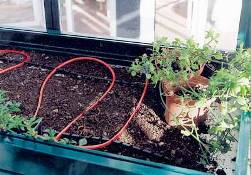 Self-regulating heating cables also indispensable when building non-freezing outdoor areas. These are such elements of buildings as steps, porches, entrances, ramps. As well as entrances to garages, parking lots, etc.
Self-regulating heating cables also indispensable when building non-freezing outdoor areas. These are such elements of buildings as steps, porches, entrances, ramps. As well as entrances to garages, parking lots, etc.
For such applications, the specific heating power is about 250 ... 350 watts / sq.m. Already at this power, the ice crust on the heated surface will be absent, and therefore it will not be necessary to chip it, damaging the coating. Such de-icing systems are especially convenient in suburban homes when it is known that a thaw and subsequent icing are expected. You can safely leave the city.
Soil heating
Cable systems are indispensable for heating soil in greenhouses and on sports lawns, as well as to prevent freezing of soil under powerful freezers. In these cases, it is also best to use a self-regulating heating cable. Despite its high cost, the system in operation will be cheaper due to the low specific energy consumption.
How is a self-regulating heating cable
A self-regulating heating cable is a semiconductor matrix consisting of many independent from each other elements.The figure below shows its schematic structure: between two conductive copper conductors, semiconductor structures are connected in parallel, conventionally shown as variable resistors.
Figure 1. Design of self-regulating heating cable.
The main property of these “variable resistors” is that they change their resistance under the influence of ambient temperature. This unique property of the elements of the heating cable is due to the fact that their TCS (temperature coefficient of resistance) is an order of magnitude higher than that of other types of semiconductors, and even more so conductors.
The lower the temperature, the lower the resistance of such a "section - resistor", and therefore the greater the current and heating power. With increasing temperature, the resistance of the section increases, and the heating power decreases, as shown in the figure. At the same time, the mutual influence of neighboring areas is minimal, and the removed elements work almost independently of their counterparts. Thus, it turns out that each element of the self-regulating heating cable is a temperature controller and a temperature sensor at the same time.
The advantages of systems based on a self-regulating heating cable include their increased safety, durability, ease of installation and operation, full automation of control without additional equipment.
An important useful operational property of such a cable should be that it can be cut into pieces of any length, starting from 20 cm. This allows you to use it without residues and scraps, and if necessary, easily add pieces of the desired size. This happens quite often, for example, when it turns out that in some place, contrary to a good design, the roof still does not thaw.
For connection to the power supply network, special couplings are included in the scope of supply. The latter are plugs and tubes of various shapes made of heat-shrinkable plastic.
Classification of heating cables
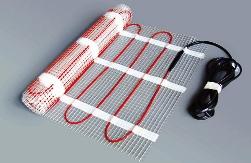 Self-regulating heating cables are divided into several types depending on application conditions and operating temperature. For example, to thaw small diameter water pipes for a country house, or air conditioning drain pipes, a cable with a temperature of 65 ° C is enough. Such a cable belongs to the category of low temperature. Its specific power, as a rule, is small and amounts to 15 W / m. The cable is fastened to the pipes using special brackets.
Self-regulating heating cables are divided into several types depending on application conditions and operating temperature. For example, to thaw small diameter water pipes for a country house, or air conditioning drain pipes, a cable with a temperature of 65 ° C is enough. Such a cable belongs to the category of low temperature. Its specific power, as a rule, is small and amounts to 15 W / m. The cable is fastened to the pipes using special brackets.
Cables with a maximum heating temperature of up to 120 ° C are recommended for use in gutters and roof de-icing systems, as well as for heating industrial pipelines of medium diameter, tanks and containers. Such cables belong to the group of medium temperature, their specific power is in the range of 10 ... 33 W / m.
To maintain the necessary temperature and protection against freezing in industrial conditions, where the volumes of pipes and tanks are large enough, it is recommended to use high-temperature self-regulating heating cables. Their maximum operating temperature reaches 190 degrees, and the specific power ranges from 15 ... 95 W / m.
The outer shells of self-regulating heating cables are made of materials resistant to aggressive chemical environments and corrosion, which allows them to be used even inside pipelines with chemicals prone to freezing and crystallization in cold conditions.
All cables, which were described above, are designed to operate on a 220 V lighting network. In addition, self-regulating heating cables with operating voltages of 12 and 24 V are produced. Their main purpose is to work in the refrigeration and construction sectors, and most importantly in vehicles.
See also at bgv.electricianexp.com
:

